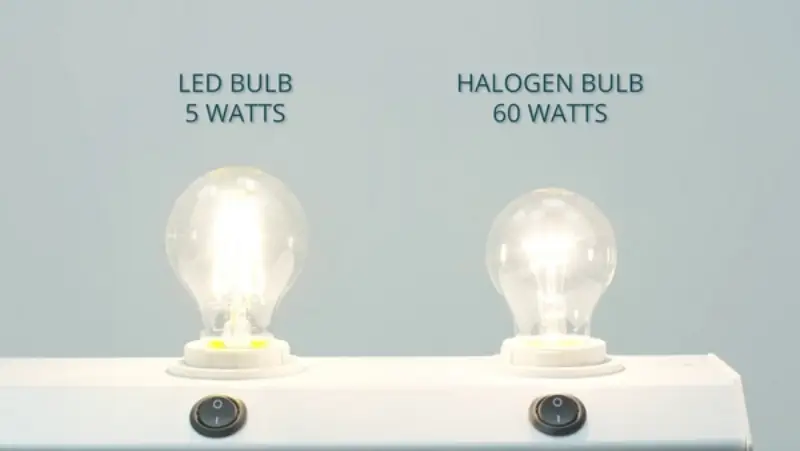Trying to replace your old 60 W lamps with 100 W lamps? Whether you are using a 100 W equivalent LED light to replace the original HID lamps (fluorescent lamp, halogen lamp, etc.) or you are just switching to a higher-wattage lamp, you should read this passage. In this passage, we will compare 60w vs 100w lamps to find out which is better. Moreover, we will also tell you if it is okay to use a 100 W bulb in a 60 W lamp. Keep reading on!
60w vs 100w: What are the differences and which is better?
Size
A 60-watt light bulb is smaller than a 100-watt light bulb. High-power lights are typically larger to dissipate heat more efficiently. Light bulbs that we use in our daily life typically have unified lampholder models that make replacement simple. As a result, the size of the light bulb increases with power. Other types of lamps can have their sizes customized to meet application-specific requirements or customer preferences.
Brightness
Before comparing the brightness of a 60W lamp and a 100W lamp, we must first determine whether the lamps are the same type. The 100W lamp will be brighter than the 60W lamp if they are of the same type.
If they are not the same type of lamps, we can’t say that the higher the power, the brighter it is. This is because in this case, we cannot measure brightness by power but by lumens, which is the brightness of the lamp observed by the human eye. High-power but low-efficiency lamps can only transform part of the electricity into light, so the lumens they emit will also be very low. Therefore, for different types of lamps, a 60W lamp may be brighter than a 100W lamp. For example, a 60W LED lamp is brighter than a 100W Halogen lamp because the efficiency of LED lamps is 2-3 times higher than that of Halogen lamps.

Resistance
The 60 W bulb is darker, which means the current flowing through the bulb is also smaller. The current decreases with increasing resistance when the voltage remains constant. Therefore, the 60 W bulb has a higher resistance. We can also analyze their resistance according to the formula R=V²/P. The resistance of the 60 W bulb is higher than the resistance of the 100 W bulb when the voltage is the same because the resistance increases with decreasing power.
Power consumption
Higher power bulbs use more electricity during specific times. A 60 W bulb consumes 0.06 kWh per hour, while a 100 W bulb consumes 0.1 kWh per hour.
Heat generation
A 100 W lamp consumes more electricity than a 60 W lamp, so it generates more heat. When choosing a lamp, you should consider whether its power meets your required brightness. Don’t choose lights with excessive power, because they will also produce excessive heat.
Applications
The applications of different types of lamps with different wattages are also different. You can refer to the following table of the applications for 60W and 100W incandescent lamps, fluorescent lamps, and LED lamps.
| Type of lamps | 60 W | 100 W |
| LED | Outdoor areas, such as courtyards | Street lighting |
| Incandescent | Small rooms, such as bedrooms | Large rooms, such as living rooms |
| Fluorescent | Larger indoor spaces, such as office halls | Commercial lighting, like shopping malls |
Can I put a 100W bulb in a 60W socket?
- Replacing a 60 W lamp with an 100 W lamp of the same type:
Using a 100W bulb in a 60W socket may result in a short circuit, open circuit, burnout, or fire. The main cause behind these failures is heat. The heat dissipation design of the 60W light can only ensure the normal operation of the 60W light. If the power output is 100W, the excessive running current will cause the fuse (if any) to burn and the wire to become overheated. You will also lose the lamp’s warranty if it is replaced. Furthermore, some 100W bulbs are bigger than 60W, so there’s a chance the bulb and the socket won’t fit. Therefore, using a 100 W bulb in a 60 W lamp is not recommended.
- Replacing the original 60W incandescent, fluorescent, halogen, etc. with a 100W equivalent LED:
If you want to use a 100W incandescent/fluorescent/halogen equivalent LED lamp, the power of this LED lamp will be much less than 60W because it is very efficient. For example, a 100W incandescent equivalent LED lamp may only be 10 to 15 watts. You should then think about whether the specifications of the lamps can be compatible. Some LED lamps employ bulb holders that are specifically made to maximize heat dissipation. The lamp’s lifespan may be shortened if the heat dissipation is poor. If you don’t care about this and just want brighter light, then you can consider replacing the original 60W lamp with a 100W equivalent LED. If it works properly, these 100W equivalent LED lamps will not cause much damage because they emit less heat than traditional lamps.
Conclusion
60W and 100W lamps are different in size, brightness, resistance, power consumption, heat generation, and application. You should choose the lamp that suits you according to your actual needs. It is not recommended to replace a 60W lamp with a 100W of the same lamp because there is a risk of burning it. Under the right conditions, you can replace the original 60W traditional lamp with a 100W equivalent LED lamp. Visit Casyoo for high-quality 100W equivalent LED lamps that can be used in different settings!




